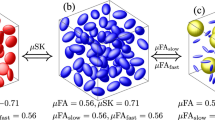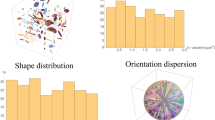Abstract
The empirical origin of random noise is described, its influence on DTI variables is illustrated by a review of numerical and in vivo studies supplemented by new simulations investigating high noise levels. A stochastic model of noise propagation is presented to structure noise impact in DTI. Finally, basics of voxelwise and spatial denoising procedures are presented. Recent denoising procedures are reviewed and consequences of the stochastic model for convenient denoising strategies are discussed.
Access this chapter
Tax calculation will be finalised at checkout
Purchases are for personal use only
Preview
Unable to display preview. Download preview PDF.
Similar content being viewed by others
References
Basser, P. J., Jones, D. K. (2002) Diffusion Tensor MRI: theory, experimental design and data analysis — a technical review. NMR Biomed. 15, 456–467
Conturo, T. E., McKinstry, R. C. et al. (1995) Diffusion MRI: Precision, accuracy and flow effects. NMR Biomed. 8, 307–332
Vlaardingerbroek, M. T., den Boer, L. A. (1996) Magnetic Resonance Imaging. Springer, Berlin Heidelberg
Henkelmann, R. M. (1985) Measurement of signal intensities in the presence of noise in MR images. Med. Phys. 12/2, 232–233
Gudbjartsson, H., Patz, S. (1995) The Rican distribution of noisy MRI data. Mag. Res. Phys. 34, 910–914
Basser, P. J., Mattiello, J., LeBihan, D. (1994) MR diffusion tensor spectroscopy and imaging. Biophys. J. 66, 259–267
Basser, P. J., Mattiello, J., LeBihan, D. (1994) Estimation of the effective self-diffusion tensor from the NMR spin echo. Journ. Mag. Res. B 103, 247–254
Messiah, A. (1972) Quantum Mechanics I. North-Holland Publishing
Press, W. P., Vetterling, W. T. et al. (1992) Numerical Recipes. University Press, Cambridge
Renyi, A., (1962) Wahrscheinlichkeitsrechnung. VEB Deutscher Verlag der Wissenschaften, Berlin
Lehmann, E. L., (1999) Elements of Large-Sample Theory. Springer, New York
Pierpaoli, C., Basser, P., (1996) Toward a quantitative assessment of diffusion anisotropy. Mag. Res. Med. 36, 893–906
Skare, S., Tie-Qiang, L. et al. (2000) Noise considerations in the determination of diffusion tensor anisotropy. Mag. Res. Im. 18, 659–669
Pajevic, S., Basser, P., (2003) Parametric and non-parametric statistical analysis of DT-MRI data. Journ. Mag. Res. 161, 1–14
Anderson, A. W. (2001) Theoretical analysis of the effects of noise on diffusion tensor imaging. Mag. Res. Med. 46, 1174–1188
Clark, C. A., Hedehus, M. et al., (2002) In vivo mapping of the fast and slow diffusion tensors in human brain. Mag. Res. Med. 47, 623–628
Jones, D., Basser, P., (2004) ’squashing peanuts and smashing pumpkins’: How noise distorts diffusion-weighted data. Mag. Res. Med. 52, 979–993
Jones, D., (2003) Determining and visualizing uncertainty in estimates of fiber orientation from diffusion tensor MRI. Mag. Res. Med. 49, 7–12
Heim, S., Hahn, K. R. et al. (2004) Assessing DTI data quality using bootstrap analysis. Mag. Res. Med. 52, 582–589
Hasan, K. M, Parker, D. L. et al. (2001) Comparison of gradient encoding schemes for diffusion-tensor MRI. Journ. Mag. Res. Im. 13, 769–780
Martin, K. M., Papadakis, N. G. et al. (1999) The reduction of the sorting bias in the eigenvalues of the diffusion tensor. Mag. Res. Im. 17, 893–901
Basser, P. J., Pajevic, S. (2000) Statistical artifacts in diffusion tensor MRI (DT-MRI) caused by background noise. Mag. Res. Med. 44, 41–50
Parker, G. J.M., Schnabel, J. A. et al. (2000) Nonlinear smoothing for reduction of systematic and random errors in diffusion tensor imaging. Journ. Mag. Res. Im. 11, 702–710
Hahn, K. R., Prigarin, S. et al. (2001) Edge preserving regularization and tracking for diffusion tensor imaging. In: Niessen W.J., Viergever, M.A. (Eds.) Medical image computing and computer-assisted intervention-MICCAI2001, Springer, Berlin, 195–203
Pajevic, S., Aldroubi, A. et al. (2002) A continous tensor field approximation of discrete DT-MRI data for extracting microstructural and architectural features of tissue. Journ. Mag. Res. 154, 85–100
Wang, Z., Vemuri, B. C. et al. (2004) A constrained variational principle for direct estimation and smoothing of the diffusion tensor field from complex DWI. IEEE Trans. Med. Im. 23, 930–939
Coulon, O., Alexander, D. C. et al. (2004) Diffusion tensor magnetic resonance image regularization. Med. Im. Anal. 8, 47–67
Poupon, C., Clark, C. A. et al. (2002) Regularization of diffusion-based direction maps for the tracking of brain white matter fascicles. NeuroImage 12, 184–195
Skare, S., Hedehus, M. et al. (2000) Condition number as a measure of noise performance of diffusion tensor data acquisition schemes with MRI. Journ. Mag. Res. 147, 340–352
Batchelor, P. G., Atkinson, D. et al. (2003) Anisotropic noise propagation in diffusion tensor MRI sampling schemes. Mag. Res. Med. 49, 1143–1151
Jones, D., (2004) The effect of gradient sampling schemes on measures derived from diffusion tensor MRI: a Monte Carlo Study. Mag. Res. Med. 51, 807–815
Hahn, K. R., Prigarin, S. et al. (2004) A novel denoising technique for very noisy DTI data. In: Conf. Proc. of 12th Annual Meeting of ISMRM. Kyoto, 1208
Author information
Authors and Affiliations
Editor information
Editors and Affiliations
Rights and permissions
Copyright information
© 2006 Springer-Verlag Berlin Heidelberg
About this chapter
Cite this chapter
Hahn, K.R., Prigarin, S., Heim, S., Hasan, K. (2006). Random Noise in Diffusion Tensor Imaging, its Destructive Impact and Some Corrections. In: Weickert, J., Hagen, H. (eds) Visualization and Processing of Tensor Fields. Mathematics and Visualization. Springer, Berlin, Heidelberg. https://doi.org/10.1007/3-540-31272-2_6
Download citation
DOI: https://doi.org/10.1007/3-540-31272-2_6
Publisher Name: Springer, Berlin, Heidelberg
Print ISBN: 978-3-540-25032-6
Online ISBN: 978-3-540-31272-7
eBook Packages: Mathematics and StatisticsMathematics and Statistics (R0)




